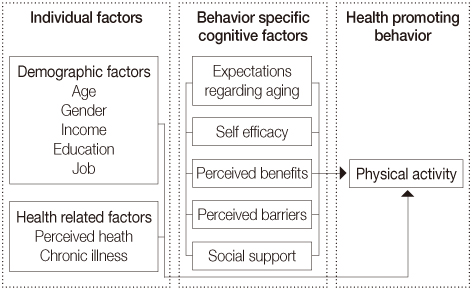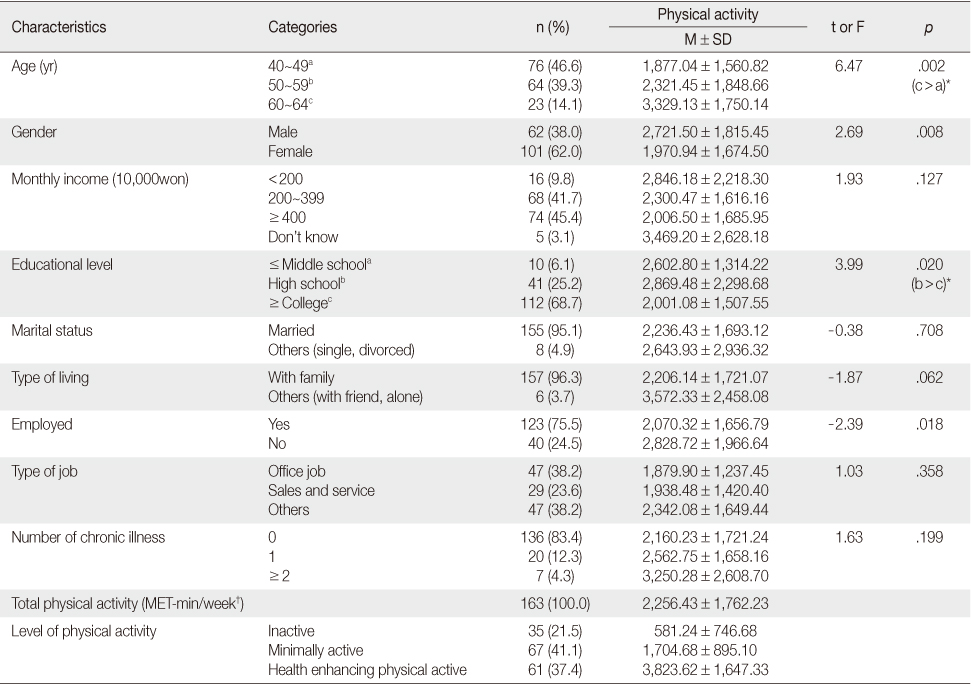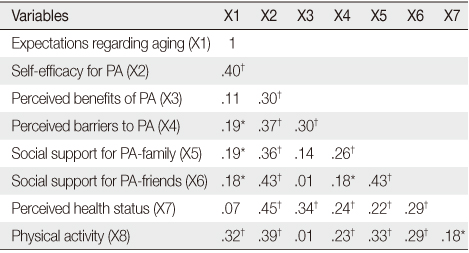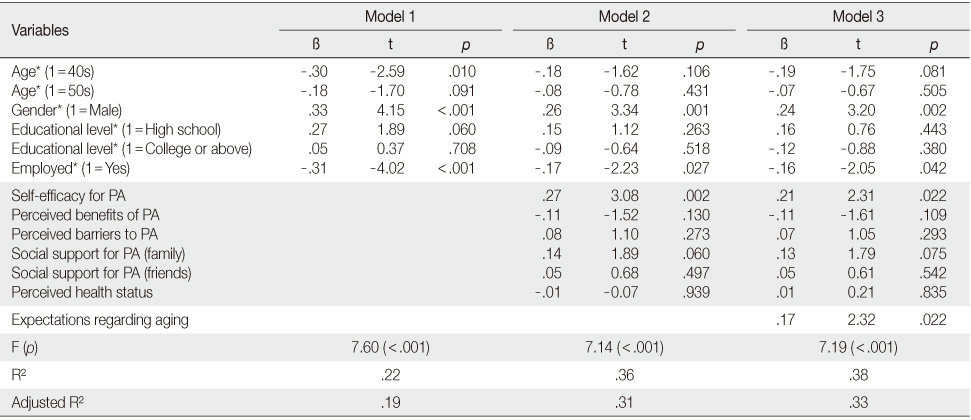Articles
- Page Path
- HOME > J Korean Acad Nurs > Volume 45(1); 2015 > Article
-
Original Article
- Relationship between Expectations Regarding Aging and Physical Activity among Middle Aged Adults in Urban Areas: Based on the Pender's Health Promotion Model
- Sung-Hye Cho, MoonKi Choi, JuHee Lee, Hyewon Cho
-
Journal of Korean Academy of Nursing 2015;45(1):14-24.
DOI: https://doi.org/10.4040/jkan.2015.45.1.14
Published online: February 27, 2015
1College of Nursing, Yonsei University, Seoul, Korea.
2College of Nursing, Kyungpook National University, Daegu, Korea.
- Address reprint requests to: Choi, MoonKi. College of Nursing, Yonsei University, 50 Yonsei-ro, Seodaemun-gu, Seoul 120-749, Korea. Tel: +82-2-2228-3259, Fax: +82-2-392-5440, miyamoong@yuhs.ac
© 2015 Korean Society of Nursing Science
This is an Open Access article distributed under the terms of the Creative Commons Attribution NoDerivs License. (http://creativecommons.org/licenses/by-nd/4.0/) If the original work is properly cited and retained without any modification or reproduction, it can be used and re-distributed in any format and medium.
Abstract
-
Purpose
- The purpose of this study was to measure the level of expectations regarding aging (ERA) and identify relationship between ERA and physical activity of middle aged adults.
-
Methods
- Participants were middle aged adults who resided in the community in three cities in Korea. Data were collected using questionnaires that contained items on individual characteristic, International Physical Activity Questionnaires (IPAQ), and behavior-specific cognitive factors including ERA-12. Hierarchical multiple regression was conducted to examine whether ERA would predict physical activity by controlling other factors.
-
Results
- The mean age of the participants was 51.1±6.9 years. The mean score for ERA (possible range=0 to 100) was 40.04±14.31. More than half of the participants (62.6%) were not engaged in health promoting physical activity. Gender, employment status and exercise confidence were associated with level of physical activity (F=7.14, p<.001, R2=.36). After controlling for individual factors and behavior-specific cognitive factors, ERA was independently related to physical activity (F=7.19, p<.001, R2=.38).
-
Conclusion
- The results demonstrate that individuals' belief about aging has effects on physical activity in Korean middle aged adults. Thus, nursing interventions which focused on ERA could help enhance physical activity in middle aged adults.
- 1. Statistics Korea. Population projections for Korea: 2010-2060 [Internet]. Daejeon, Author. 2011;cited 2011 December 27. Available from: http://kosis.kr/ups/ups_01List01.jsp?pubcode=PJ
- 2. Kweon YR, Jeon HO. Effects of perceived health status, self-esteem and family function on expectations regarding aging among middle-aged women. J Korean Acad Nurs. 2013;43(2):176–184. ArticlePubMed
- 3. Song MS, Yoo YK, Choi CH, Kim NC. Effects of Nordic walking on body composition, muscle strength, and lipid profile in elderly women. Asian Nurs Res. 2013;7(1):1–7.Article
- 4. Thompson PD, Buchner D, Piña IL, Balady GJ, Williams MA, Marcus BH, et al. Exercise and physical activity in the prevention and treatment of atherosclerotic cardiovascular disease: A statement from the council on clinical cardiology (subcommittee on exercise, rehabilitation, and prevention) and the council on nutrition, physical activity, and metabolism (subcommittee on physical activity). Circulation. 2003;107(24):3109–3116. ArticlePubMed
- 5. Ministry of Health & Welfare, Korea Centers for Disease Control & Prevention. Korea health statistics 2012: Korea national health and nutrition examination survey (KNHANES V-3). Seoul: Ministry of Health & Welfare; 2013.
- 6. Shin HS, Lee J, Lee KH, Song YA. Health behavioral patterns associated with psychologic distress among middle-aged Korean women. Asian Nurs Res. 2007;1(1):61–67. Article
- 7. Lee MS, Woo MK, Kim IS. Follow-up study of health-related habits and health status of middle-aged men and women in Chonju. Korean J Community Nutr. 2000;5(2):185–192.
- 8. Sarkisian CA, Prohaska TR, Wong MD, Hirsch S, Mangione CM. The relationship between expectations for aging and physical activity among older adults. J Gen Intern Med. 2005;20(10):911–915. ArticlePubMedPMC
- 9. Angus J, Reeve P. Ageism: A threat to "aging well" in the 21st century. J Appl Gerontol. 2006;25(2):137–152. ArticlePDF
- 10. Levy BR, Myers LM. Preventive health behaviors influenced by self-perceptions of aging. Prev Med. 2004;39(3):625–629. ArticlePubMed
- 11. Pender NJ. Health promotion in nursing practice. 3rd ed. Stamford, CT: Appleton & Lange; 1996.
- 12. Lee KJ, Chang CJ, Yoo JH, Yi YJ. Factors effecting health promoting behaviors in middle-aged women. J Korean Acad Nurs. 2005;35(3):494–502.ArticlePDF
- 13. Cho SH, Lee H. Factors associated with physical activity among Chinese immigrant women. J Korean Acad Nurs. 2013;43(6):760–769. ArticlePubMed
- 14. Choi JA. Construction of leisure physical activity model of middle-aged women in urban area. J Korean Acad Adult Nurs. 2008;20(4):626–640.
- 15. Oh SJ, Kim JI, Chae YR. A study on exercise performance and its relating factors in middle-aged women. Korean J Women Health Nurs. 2010;16(4):348–359. ArticlePubMed
- 16. Choe MA, Hah YS, Kim KS, Yi M, Choi JA. A study on exercise behavior, exercise environment and social support of middle-aged women. J Korean Acad Nurs. 2008;38(1):101–110. Article
- 17. Cottrell RR, Girvan JT, McKenzie JF. Principles and foundations of health promotion and education. 2nd ed. San Francisco, CA: Benjamin Cummings; 2001.
- 18. Sarkisian CA, Steers WN, Hays RD, Mangione CM. Development of the 12-item expectations regarding aging survey. Gerontologist. 2005;45(2):240–248.ArticlePubMed
- 19. International Physical Activity Questionnaire. Downloadable questionnaires: Korean (Korea) [Internet]. Solna, SE, Author. 2006;cited 2013 October 1. Available from: https://docs.google.com/viewer?a=v&pid=sites&srcid=ZGVmYXVsdGRvbWFpbnx0aGVpcGFxfGd4OjViMGM2OWI3Mjc5NjBjMTE
- 20. Faul F, Erdfelder E, Buchner A, Lang AG. Statistical power analyses using G*Power 3.1: Tests for correlation and regression analyses. Behav Res Methods. 2009;41(4):1149–1160. ArticlePubMedPDF
- 21. Craig CL, Marshall AL, Sjöström M, Bauman AE, Booth ML, Ainsworth BE, et al. International physical activity questionnaire: 12-country reliability and validity. Med Sci Sports Exerc. 2003;35(8):1381–1395. ArticlePubMed
- 22. International Physical Activity Questionnaire. Guidelines for data processing and analysis of the international physical activity questionnaire (IPAQ): Short and long forms [Internet]. Solna, SE, Author. 2005;cited 2013 October 1. Available from: http://www.ipaq.ki.se/scoring.pdf
- 23. Sallis JF, Pinski RB, Grossman RM, Patterson TL, Nader PR. The development of self-efficacy scales for health-related diet and exercise behaviors. Health Educ Res. 1988;3(3):283–292. Article
- 24. Plotnikoff RC, Blanchard C, Hotz SB, Rhodes R. Validation of the decisional balance scales in the exercise domain from the transtheoretical model: A longitudinal test. Meas Phys Educ Exerc Sci. 2001;5(4):191–206. Article
- 25. Sallis JF, Grossman RM, Pinski RB, Patterson TL, Nader PR. The development of scales to measure social support for diet and exercise behaviors. Prev Med. 1987;16(6):825–836.ArticlePubMed
- 26. Lawton MP, Moss M, Fulcomer M, Kleban MH. A research and service oriented multilevel assessment instrument. J Gerontol. 1982;37(1):91–99.ArticlePubMed
- 27. Kim SH. The association between expectations regarding aging and health-promoting behaviors among Korean older adults. J Korean Acad Nurs. 2007;37(6):932–940.ArticlePDF
- 28. Levy BR, Slade MD, Kunkel SR, Kasl SV. Longevity increased by positive self-perceptions of aging. J Pers Soc Psychol. 2002;83(2):261–270.ArticlePubMed
- 29. Li X, Lv Q, Li C, Zhang H, Li C, Jin J. The relationship between expectation regarding aging and functional health status among older adults in China. J Nurs Scholarsh. 2013;45(4):328–335. ArticlePubMedPDF
- 30. Haskell WL, Lee IM, Pate RR, Powell KE, Blair SN, Franklin BA, et al. Physical activity and public health: Updated recommendation for adults from the American College of Sports Medicine and the American Heart Association. Circulation. 2007;116(9):1081–1093. ArticlePubMed
REFERENCES
Figure & Data
REFERENCES
Citations

- The Relationship Among Stress, Sense of Coherence and Sleep Quality in Middle-aged Women
So Hyeon Kim, So Young Choi
Journal of Korean Maternal and Child Health.2025; 29(3): 137. CrossRef - Family care and health-promoting behaviors among community elders: The chain mediating effect of self-efficacy and aging expectations
Yian Chen, Lin Zhang, Jiashuang Xu, Miaojing Song, Pengjuan Ji, Qiqi Ji, Leilei Guo
Geriatric Nursing.2025; 66: 103606. CrossRef - The Effects of Health Status and Social Support on Happiness in MiddleAged Women
Bok Hui Baek, So Young Choi
Journal of Korean Public Health Nursing.2024; 38(1): 16. CrossRef - Impact of WhatsApp-Based Self-Care Education on Self-Care Behaviors and Lifestyle in Overweight and Obese Pregnant Women with Diabetes: A Randomized Controlled Trial
Fatemeh Salarkarimi, Majid Karandish, Mehrnoosh Zakerkish, Zahra Abbaspoor
Jundishapur Journal of Chronic Disease Care.2024;[Epub] CrossRef - The Level of Expectations Regarding Aging Among Older Adults: A Systematic Review and Meta-analysis
Lunwei Lin, Shunqi Liao, Zhangrong Yan, Chaofan Liu, Qi Wang, Fang Wang
Journal of the American Medical Directors Association.2024; 25(3): 410. CrossRef - The Effect of a Training Intervention Based on Pender’s Health Promotion Model on the Lifestyle of Patients Undergoing Hemodialysis
Hossein Hassannezhad, Hasan Robabi, Fatihe Kerman Saravi
Medical-Surgical Nursing Journal.2024;[Epub] CrossRef - Validity and Reliability of Persian Version of the 12-Item Expectations Regarding Aging Survey
Hamid Sharif Nia, Long She, Sotheeswari Somasundram, Fatemeh Khoshnavay Fomani, Omolhoda Kaveh, Lida Hosseini
The International Journal of Aging and Human Development.2023; 96(2): 248. CrossRef - Health-Related Expectations Regarding Aging among Middle-Aged and Older Japanese: Psychometric Performance and Novel Findings from the ERA-12-J
Michael Annear, Yasuo Shimizu, Tetsuhiro Kidokoro
International Journal of Environmental Research and Public Health.2022; 19(20): 13509. CrossRef - Factors Influencing the Physical Activity of Foreign Workers: Based on a Health Promotion Model
Jeong Eui Cho, Yeongmi Ha
Journal of Korean Academy of Community Health Nursing.2021; 32(3): 344. CrossRef - Lower serum levels of alpha tocopherol and lycopene are associated with higher pain and physical disability in subjects with primary knee osteoarthritis: A case-control study
Bina Eftekharsadat, Dawood Aghamohammadi, Neda Dolatkhah, Maryam Hashemian, Halale Salami
International Journal for Vitamin and Nutrition Research.2021; 91(3-4): 304. CrossRef - Effects of a Daily Life-Based Physical Activity Enhancement Program for Middle-Aged Women at Risk for Cardiovascular Disease
Kyung Ae Kim, Seon Young Hwang
Journal of Korean Academy of Nursing.2019; 49(2): 113. CrossRef - Applying the theory of planned behavior to determine factors associated with physical activity by women with hypertension in rural areas of Iran
Effat Hatefnia, Kobra Alizadeh, Mostafa Ghorbani
Asian Biomedicine.2019; 12(2): 83. CrossRef - Factors Affecting the Successful Aging of Late Middle-Aged Adults
YonJi Kim, JuHee Lee, Young Joo Lee
Korean Journal of Health Promotion.2018; 18(2): 90. CrossRef - Factors Influencing Exercise Behavior of the Male Manual Worker and Office Worker based on Health Promotion Model
SeungKyoung Yang, Yeongmi Ha, Mi-Ra Jung
Korean Journal of Occupational Health Nursing.2015; 24(3): 235. CrossRef

Figure 1
Relationship between Individual Characteristics and Physical Activity (N=163)
*Scheffé test result; †MET level x minutes of activity x events per week; MET level: Vigorous intensity (8), Moderate intensity (4), Walking (3.3).
Descriptive Statistics for Measured Variables (N=163)
PA=Physical activity.
Correlation Matrix among Measured Variables (N=163)
*p<.05; †p<.01; PA=Physical activity.
Hierarchical Multiple Regression of Expectation Regarding Aging on Physical Activity (N=163)
*Dummy variables; β=Standardized beta; PA=Physical activity.
*Scheffé test result; †MET level x minutes of activity x events per week; MET level: Vigorous intensity (8), Moderate intensity (4), Walking (3.3).
PA=Physical activity.
*
*Dummy variables; β=Standardized beta; PA=Physical activity.
 KSNS
KSNS
 E-SUBMISSION
E-SUBMISSION





 Cite
Cite

